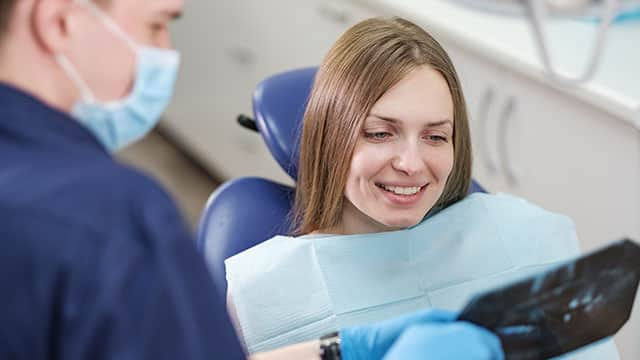What Is Regional Odontodysplasia?
A helpful way to understand this condition is to break down the term into its parts.
- Regional
It affects one or several adjacent teeth. - Odonto
This means the condition relates to your teeth. - Dysplasia
Dysplasia refers to the presence of abnormal cells in organs or tissues in your body.
In this case, what's abnormal is that there isn't enough enamel and dentin, two of the four main parts of every tooth.
- Enamel
The hard, protective outer layer of a tooth above your gums. - Cementum
The hard, protective outer layer beneath your gums. - Dentin
The tissue beneath the enamel and cementum that makes up most of your tooth. - Pulp
The inside of your tooth, where the root and the nerves reside.
Because the enamel and dentin don't sufficiently grow in ghost teeth, your pulp chamber will be unusually large, which is why the ghostlike appearance happens in radiographs.
Regional odontodysplasia often results in discoloration, softness in your teeth, abnormal structure, and increased susceptibility to gum disease, swelling, pain, and abscesses. Ghost teeth are often accompanied by delayed, failed, or incomplete tooth eruption.
Learn about similar conditions, dentin dysplasia, and dentinogenesis imperfecta.
What Causes Ghost Teeth?
The causes of ghost teeth are unknown, but according to the Journal of Pharmacy and BioAllied Sciences, some experts have suggested the following as possible culprits:
- Metabolic syndromes
The Mayo Clinic defines metabolic syndromes as "a cluster of conditions that occur together, increasing your risk of heart disease, stroke, and type 2 diabetes." - Rh incompatibility
This occurs when a pregnant woman has Rh-negative blood and the baby in her womb has Rh-positive blood.
- Viral infections
Viruses are smaller than bacteria, get inside living cells, and cause them to multiply. Viral infections that are thought to cause ghost teeth would likely be latent in the gums where teeth are formed.
- Local trauma
If an infant had a blow to their face near their mouth, it could be the reason for their regional odontodysplasia. - Vascular defects
Aneurysms, arteriovenous malformations, moyamoya disease, and pediatric stroke are common conditions that cause vascular defects. - Irradiation
Radiation exposure may result in ghost teeth. - Medications during pregnancy
Certain medications may result in a newborn developing ghost teeth. If you're pregnant and take medication, speak with your medical professional to determine any potential complications that may arise.
Ghost teeth are considered nonhereditary, meaning the condition is not passed down from parents to children. A study in Contemporary Clinical Dentistry states that it most often occurs in the upper teeth on one side and affects females more commonly than males.
Treatment for Ghost Teeth
Treatment of regional odontodysplasia often requires a collaborative effort between several different specialists, including pediatric dentists, orthodontists, prosthodontists, and oral surgeons.
Ghost teeth may need to be extracted if they have abscesses. Some dental professionals prefer to extract all teeth affected by this condition, as they are already weakened. Other dental professionals prefer to restore the weakened tooth structure with a filling material to keep it functional as long as possible. If you have a child with ghost teeth, your dental professional may recommend replacing affected teeth with dental implants when they reach the age that their jaw stops growing.
Practicing Good Oral Hygiene With Ghost Teeth
Practicing good oral hygiene is always important, but especially so with a condition like ghost teeth that makes you more susceptible to gum disease and tooth decay. Brush at least twice a day. Clean between your teeth with interdental brushes or water flossers at least once a day. Consider using other helpful products like an antimicrobial mouthrinse and a tongue scraper. And see your dental professional for regular appointments.
If you think that you or your child have regional odontodysplasia and it hasn't been diagnosed yet, visit your dental professional as soon as possible. They'll be able to work with you to come up with the best possible treatment plan according to your specific needs.
Oral Care Center articles are reviewed by an oral health medical professional. This information is for educational purposes only. This content is not intended to be a substitute for professional medical advice, diagnosis or treatment. Always seek the advice of your dentist, physician or other qualified healthcare provider.
ORAL HEALTH QUIZ
What's behind your smile?
Take our Oral Health assessment to get the most from your oral care routine
ORAL HEALTH QUIZ
What's behind your smile?
Take our Oral Health assessment to get the most from your oral care routine
Join Us
Get the best of your oral health routine and take it to the next level with expert advice, recommendations, products and solutions and special offers.
Join Us
Get the best of your oral health routine and take it to the next level with expert advice, recommendations, products and solutions and special offers.















